- Joined
- Oct 10, 2018
- Messages
- 543
It comes up again and again how moving the head on an RF-30 style mill-drill is such a pain because of losing positional accuracy.
So don't do that!
I hope this thread might collect some of the strategies people use to avoid having to change the height of the head. For example, use stubby drills instead of jobber length. My 1/2" ∅ stubby is 4 inches long versus 6 inches for the jobber drill*. Being shorter and less flexible, the stubby often doesn't need a spot drill to start. Even if it does, it is short enough that one set up can do both the centre drill starter and finish the hole with the stubby.
Even better, use actual spotting drills rather than a centre drill to start. Spotting drills are generally close to stubby length so the head can stay in one position for both operations. Spotting drills are also fine for chamfering in many cases so again you can avoid switching to a really short chamfer bit.
Another common situation is where you want to set up a piece and drill some holes and mill some features without moving the part. The obvious approach is to switch between a drill chuck for drilling and collets for milling. The trouble is that a typical 5/8" drill chuck often eats up 3 to 4 inches of the vertical travel. One way to avoid that problem is...don't use a drill chuck. Mount your drill in a collet, if possible. Again, stubby drills are close enough to the length of common end mills that you will have sufficient travel to do the required operations. Another option is to use a smaller drill chuck when appropriate. A 1/4 or 3/8 inch capacity chuck generally occupies a bit less vertical height and may keep you within the Z envelope.
So, what do you say? Any more strategies on getting stuff done without having to reposition the head on an RF-30?
Craig
* my stubby 1/2" drill has 2 inches of flute length. For most of my projects, the stubby is sufficiently long but, from time to time, you're going to need the extra length of a jobber (or longer) drill. Can't win them all!
So don't do that!
I hope this thread might collect some of the strategies people use to avoid having to change the height of the head. For example, use stubby drills instead of jobber length. My 1/2" ∅ stubby is 4 inches long versus 6 inches for the jobber drill*. Being shorter and less flexible, the stubby often doesn't need a spot drill to start. Even if it does, it is short enough that one set up can do both the centre drill starter and finish the hole with the stubby.
Even better, use actual spotting drills rather than a centre drill to start. Spotting drills are generally close to stubby length so the head can stay in one position for both operations. Spotting drills are also fine for chamfering in many cases so again you can avoid switching to a really short chamfer bit.
Another common situation is where you want to set up a piece and drill some holes and mill some features without moving the part. The obvious approach is to switch between a drill chuck for drilling and collets for milling. The trouble is that a typical 5/8" drill chuck often eats up 3 to 4 inches of the vertical travel. One way to avoid that problem is...don't use a drill chuck. Mount your drill in a collet, if possible. Again, stubby drills are close enough to the length of common end mills that you will have sufficient travel to do the required operations. Another option is to use a smaller drill chuck when appropriate. A 1/4 or 3/8 inch capacity chuck generally occupies a bit less vertical height and may keep you within the Z envelope.
So, what do you say? Any more strategies on getting stuff done without having to reposition the head on an RF-30?
Craig
* my stubby 1/2" drill has 2 inches of flute length. For most of my projects, the stubby is sufficiently long but, from time to time, you're going to need the extra length of a jobber (or longer) drill. Can't win them all!


